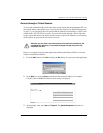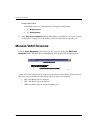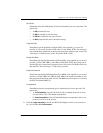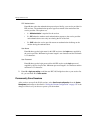
Appendix A: Accessing the Command-Line Interface
MM701G and MM702G User Manual 111
QoS Class
Enter 4 then select the ATM Quality of Service indicated by your service provider. The
options are:
•
1—CBR (constant bit rate)
•
2—VBR-rt (variable bit rate real-time)
•
3—VBR-nrt (variable bit rate non-real-time)
•
4—UBR (unspecified bit rate is the default setting)
Peak Cell Rate
Enter 5 then type the QoS Peak Cell Rate (PCR) value supplied by your service
provider. If you are not provided a PCR value, use the default. PCR is the maximum
rate at which data is transferred on the line and measured in ATM cells per second. The
valid range is 1-5500 cells per second. The default PCR is 5500.
Sustain Cell Rate
Enter 6 then type the QoS Sustainable Cell Rate (SCR) value supplied by your service
provider. Use for CBR, VBR-rt, and VBR-nrt ATM QoS. SCR is the average rate at
which ATM cells are transferred, measured in cells per second. The SCR must be less
than the PCR. The valid range is 1-5500 cells per second.
Maximum burst size
Enter 7 then type the QoS Maximum Burst Size (MBS) value supplied by your service
provider. Use with VBR-rt and VBR-nrt QoS. MBS is the maximum number of cells
that can be transmitted at the peak cell rate. The MBS rate must be equal to or less than
the PCR. The default MBS is 0.
Encapsulation
Type 8 then select the encapsulation type as indicated by the service provider. The
options are:
•
1—Llc Encapsulation (Logical Link Control) allows multiple protocols to be run
over the session. This is the default encapsulation.
•
2—Vcmux (Virtual Channel Multiplexer) encapsulation allows one protocol to be
run over the session.
WAN DHCP Enable
Type 9 then select 1 to Disable or 2 to Enable DHCP client. Enabling DHCP client
provides the capability where this session will automatically received an IP address


















